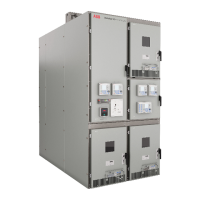COMMISSIONING AND TESTING GUIDE 25
—
Primary testing-voltage sensors
Primary testing verifies the whole measurement
chain including the sensor, cable connections and
settings of the protection relay. Physical polarity
of the voltage sensor is unique, only one-way
installation is possible. Therefore, no polarity
check (physical test) is needed.
All voltage sensors are tested individually during
routine production tests for output accuracy and
determination of the ratio correction factors.
Production test reports are available for all
sensors and are provided when requested. It is
not required to test the sensors separately from
the entire chain.
If it is desired to test only the sensors, separate
from the entire circuit, then follow only the steps
shown below that are necessary to establish a
primary current injection circuit and then connect
a measurement device to the RJ45 connectors of
the sensor outputs. Please note that the
measurement and power supply devices are
suggested devices. Performance characteristics
are stated in case the user wants to use alternate
power supply and measuring devices.
The measurement device should have a
measurement range of 5 mV to 20 V, with an
accuracy of +/-0.1% or better. All voltage sensors
are factory tested for accuracy in the primary
voltage operating range, i.e., from 2% of rated
primary voltage up to the 190% of rated primary
voltage. These routine tests are made per the
requirements of the sensor standards IEC
60044-7 or IEC 61869-11.
Only one of the primary voltage inputs needs to
be tested. Since voltage sensors are linear in
performance it is not necessary to test all primary
inputs. If the tests are within required ranges for
one input, they will be in range for all inputs.
The chart below shows what the output voltage
should be based on the primary voltage used. The
acceptable output range is +/- 6.0 for 2 % of rated
primary voltage or 5.0 % of the remaining target
values shown on the chart below which also
expresses the accuracy limits according to IEC
standards with applied correction factors.
Multiply the ratio correction factor (ref. Step 1/7
below) by the actual output voltage. This
calculated value based on the correction factors
should be within +/- 0.5% of the secondary
output values shown in the table in the range
from 80% to 120% of the rated primary voltage,
within +/- 3% in the range from 5% to 190% of the
rated primary voltage (except 80% to 120% of
Upn) and +/- 6% in the range from 2% to 5% of
the rated primary voltage
Primary
Voltage Input
Secondary
Output (mV)²
Accuracy
limits
according to
IEC standards
—
1. Primary injection test equipment assumed to have a +/-0.1% accuracy or better
4. Output voltage to be +/-x% of the values shown in the table and according to the
limits defined by the standards for accuracy class 0.5/3P. (e.g., for 8660 Vac
primary, output voltage can be 862 to 870 mV). Consideration shall also be given to
the accuracy range of the primary voltage injection equipment.
5. All values based on 60Hz.

